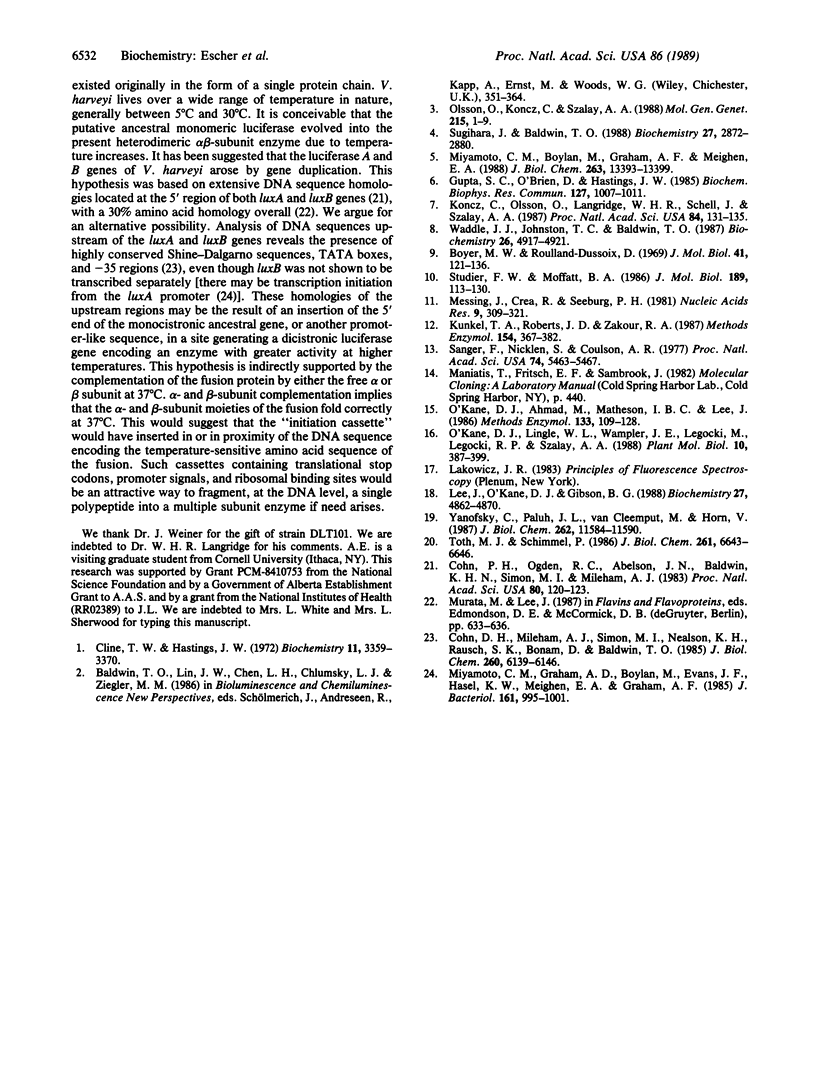Abstract
A 2.2-kilobase-pair (kbp) DNA fragment from Vibrio harveyi contains the luxA and luxB genes separated by a 26-base-pair (bp) intergenic region. The two genes were converted to a single open reading frame by site-specific mutagenesis. A full-length fusion protein is obtained when the new gene is placed under transcriptional control of a T7 promoter in Escherichia coli. Bioluminescence of colonies containing the gene fusion is 0.002% of the wild-type luciferase [alkanal monooxygenase (FMN-linked); alkanal, reduced-FMN:oxygen oxidoreductase (1-hydroxylating, luminescing), EC 1.14.14.3] at 37 degrees C. Growth at 23 degrees C results in a greater than 50,000-fold increase in light emission in cells containing fusion protein, whereas only a 3-fold increase in observed with cells containing the luxAB dicistron. Purified fusion protein isolated from E. coli grown at 19 degrees C exists in both monomeric and dimeric forms with specific bioluminescence activities comparable to the heterodimeric wild-type enzyme at 23 degrees C and 37 degrees C. These findings show that the alpha beta fusion polypeptide is functional as a monomer and suggest that its folding is drastically affected at elevated temperature. We hypothesize that the two-subunit bacterial luciferase may have evolved from a monomer as a result of a temperature increase in the environment.
Full text
PDF




Images in this article
Selected References
These references are in PubMed. This may not be the complete list of references from this article.
- Cline T. W., Hastings J. W. Mutationally altered bacterial luciferase. Implications for subunit functions. Biochemistry. 1972 Aug 29;11(18):3359–3370. doi: 10.1021/bi00768a008. [DOI] [PubMed] [Google Scholar]
- Cohn D. H., Mileham A. J., Simon M. I., Nealson K. H., Rausch S. K., Bonam D., Baldwin T. O. Nucleotide sequence of the luxA gene of Vibrio harveyi and the complete amino acid sequence of the alpha subunit of bacterial luciferase. J Biol Chem. 1985 May 25;260(10):6139–6146. [PubMed] [Google Scholar]
- Cohn D. H., Ogden R. C., Abelson J. N., Baldwin T. O., Nealson K. H., Simon M. I., Mileham A. J. Cloning of the Vibrio harveyi luciferase genes: use of a synthetic oligonucleotide probe. Proc Natl Acad Sci U S A. 1983 Jan;80(1):120–123. doi: 10.1073/pnas.80.1.120. [DOI] [PMC free article] [PubMed] [Google Scholar]
- Gupta S. C., O'Brien D., Hastings J. W. Expression of the cloned subunits of bacterial luciferase from separate replicons. Biochem Biophys Res Commun. 1985 Mar 29;127(3):1007–1011. doi: 10.1016/s0006-291x(85)80044-9. [DOI] [PubMed] [Google Scholar]
- Hoober J. K., Blobel G. Characterization of the chloroplastic and cytoplasmic ribosomes of Chlamydomonas reinhardi. J Mol Biol. 1969 Apr 14;41(1):121–138. doi: 10.1016/0022-2836(69)90130-2. [DOI] [PubMed] [Google Scholar]
- Koncz C., Olsson O., Langridge W. H., Schell J., Szalay A. A. Expression and assembly of functional bacterial luciferase in plants. Proc Natl Acad Sci U S A. 1987 Jan;84(1):131–135. doi: 10.1073/pnas.84.1.131. [DOI] [PMC free article] [PubMed] [Google Scholar]
- Kunkel T. A., Roberts J. D., Zakour R. A. Rapid and efficient site-specific mutagenesis without phenotypic selection. Methods Enzymol. 1987;154:367–382. doi: 10.1016/0076-6879(87)54085-x. [DOI] [PubMed] [Google Scholar]
- Lee J., O'Kane D. J., Gibson B. G. Dynamic fluorescence properties of bacterial luciferase intermediates. Biochemistry. 1988 Jun 28;27(13):4862–4870. doi: 10.1021/bi00413a042. [DOI] [PubMed] [Google Scholar]
- Messing J., Crea R., Seeburg P. H. A system for shotgun DNA sequencing. Nucleic Acids Res. 1981 Jan 24;9(2):309–321. doi: 10.1093/nar/9.2.309. [DOI] [PMC free article] [PubMed] [Google Scholar]
- Miyamoto C. M., Boylan M., Graham A. F., Meighen E. A. Organization of the lux structural genes of Vibrio harveyi. Expression under the T7 bacteriophage promoter, mRNA analysis, and nucleotide sequence of the luxD gene. J Biol Chem. 1988 Sep 15;263(26):13393–13399. [PubMed] [Google Scholar]
- Miyamoto C. M., Graham A. D., Boylan M., Evans J. F., Hasel K. W., Meighen E. A., Graham A. F. Polycistronic mRNAs code for polypeptides of the Vibrio harveyi luminescence system. J Bacteriol. 1985 Mar;161(3):995–1001. doi: 10.1128/jb.161.3.995-1001.1985. [DOI] [PMC free article] [PubMed] [Google Scholar]
- O'Kane D. J., Ahmad M., Matheson I. B., Lee J. Purification of bacterial luciferase by high-performance liquid chromatography. Methods Enzymol. 1986;133:109–128. doi: 10.1016/0076-6879(86)33059-3. [DOI] [PubMed] [Google Scholar]
- Olsson O., Koncz C., Szalay A. A. The use of the luxA gene of the bacterial luciferase operon as a reporter gene. Mol Gen Genet. 1988 Dec;215(1):1–9. doi: 10.1007/BF00331295. [DOI] [PubMed] [Google Scholar]
- Sanger F., Nicklen S., Coulson A. R. DNA sequencing with chain-terminating inhibitors. Proc Natl Acad Sci U S A. 1977 Dec;74(12):5463–5467. doi: 10.1073/pnas.74.12.5463. [DOI] [PMC free article] [PubMed] [Google Scholar]
- Studier F. W., Moffatt B. A. Use of bacteriophage T7 RNA polymerase to direct selective high-level expression of cloned genes. J Mol Biol. 1986 May 5;189(1):113–130. doi: 10.1016/0022-2836(86)90385-2. [DOI] [PubMed] [Google Scholar]
- Sugihara J., Baldwin T. O. Effects of 3' end deletions from the Vibrio harveyi luxB gene on luciferase subunit folding and enzyme assembly: generation of temperature-sensitive polypeptide folding mutants. Biochemistry. 1988 Apr 19;27(8):2872–2880. doi: 10.1021/bi00408a031. [DOI] [PubMed] [Google Scholar]
- Toth M. J., Schimmel P. Internal structural features of E. coli glycyl-tRNA synthetase examined by subunit polypeptide chain fusions. J Biol Chem. 1986 May 25;261(15):6643–6646. [PubMed] [Google Scholar]
- Waddle J. J., Johnston T. C., Baldwin T. O. Polypeptide folding and dimerization in bacterial luciferase occur by a concerted mechanism in vivo. Biochemistry. 1987 Aug 11;26(16):4917–4921. doi: 10.1021/bi00390a004. [DOI] [PubMed] [Google Scholar]
- Yanofsky C., Paluh J. L., van Cleemput M., Horn V. Fusion of trpB and trpA of Escherichia coli yields a partially active tryptophan synthetase polypeptide. J Biol Chem. 1987 Aug 25;262(24):11584–11590. [PubMed] [Google Scholar]




